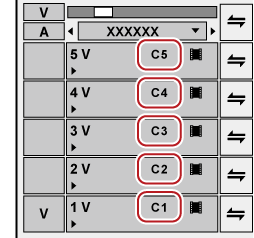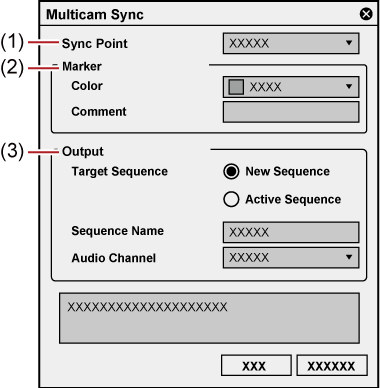Multicam mode is a function that enables video shots of one subject recorded by multiple cameras to be displayed simultaneously and switched to the scene to be used. In the multicam mode, you can play back and edit multiple clips on up to 16 screens simultaneously.
1) Click [Mode] on the menu bar, and click [Multicam Mode].
The preview window switches from the standard mode to the multicam mode.
When the preview window is displayed in the dual mode, the left side is the divided screen corresponding to the number of cameras, and the right side is the master (selected camera).
When the preview window is displayed in the single mode, the screen is the divided screen corresponding to the number of cameras. The screen can also be set to display only the master.
[Camera mapping] is displayed on the track panel of the timeline window.

 Alternative
Alternative
Switching to the multicam mode: [F8]

When the mode is switched to the multicam mode with clips placed on the timeline, the camera switch point is automatically set to the In and Out points of each clip. To change the camera switch point, overwrite it.
When the preview window is displayed in the single mode, the display can be switched between the selected camera only display and the divided screen. Click [Mode] on the menu bar, and click [View Multicam] → [Show Only the Selected Camera in Single Monitor Mode].
The multicam mode can be switched to the standard mode by the following operation.
Click [Mode] on the menu bar, and click [Normal Mode] or [Multicam Mode].
Press [F8] on the keyboard again.
Switching to standard mode: [F5]
Operations on clips or tracks in the multicam mode are the same as in the standard mode, however, shortcut keys differ from those in the standard mode.
|
|
|---|
|
You can switch the number of multicamera screens on the Recorder.
1) Click [Mode] on the menu bar, and click [Number of Cameras] → an item.
You can select a sync point as the reference point used when multiple clips are placed, and then place clips.
1) Select and right-click the multiple clips in the bin, and click [Create Multicam Sequence].
The [Create Multicam Sequence] dialog box appears.
2) Set each item, and click [OK].
A new sequence will be created, and clips will be placed in accordance with the selected sync point. The sequence will be registered to the bin as a timeline sequence clip.
Multicam mode will be set to the created sequence.
The camera switch point is automatically set to the In and Out points of each clip. To change the camera switch point, overwrite it.
Clips placed on the timeline are displayed on the Recorder in the multicam screen.
|
|
|---|
|

|
(1) |
[Sync Point] |
Select a sync point as the reference point for clips to be placed. [Timecode] Place a clip onto individual tracks referenced to the start timecode of each clip. When the clip has no start timecode, the start timecode is assumed to be “00:00:00;00”. [Rec Time] Place a clip onto individual tracks referenced to the recording time of each clip. When the clip has no start time, the recording time is assumed to be “00:00:00”. (The recording time is taken as the reference regardless of the recording date.) [Clip Marker] Clips are placed onto separate tracks using the clip marker position of each clip as the reference point. In [Marker Comment], enter the string that has been entered in [Comments] of the reference clip marker. A clip will be placed using the clip marker with the string of exact match as the reference point.
[Clip In] Place a clip onto individual tracks referenced to the In point timecode of the clip. If the clip has no start In point timecode, the top of the clip is taken as the reference. [Clip Out] Place a clip onto individual tracks referenced to the Out point timecode of the clip. If the clip has no start Out point timecode, the end of the clip is taken as the reference. |
|
(2) |
[Sequence] |
Set the details of the sequence that is created when clips are placed. A sequence will be created in accordance with the current project settings. Multicam mode will be set to the created sequence. [Sequence Name] Enter the name of the sequence. [Audio Channel] Select the audio channel from [Monaural] and [Stereo]. |
You can change the camera assigned to each track.
When clips have been placed on the timeline in the multicam mode, cameras are assigned in the track number order of V/A tracks containing clips.
1) Click [Camera mapping] on the track panel of the V/A track.

2) Click the camera to assign to the selected track.
Click [Unmap] to release the assignment set to the selected track.
Click [Default] to initialize all camera assignments set to the tracks. Cameras will be reassigned in order of track numbers of the V track. Camera assignment to the A track will be released.

[Camera mapping] is displayed only in the multicam mode.
Tracks not assigned a camera are not displayed in the multicam mode.
You can change camera assignments during editing.
You can switch the display/hide setting for the track name at the upper left of each screen of the multicam mode. Click [Mode] on the menu bar, and click [View Multicam] → [Display Track Name] to uncheck the item.
Set the preview display during editing in the multicam mode.
1) Click [Mode] on the menu bar, and click [View Multicam] → an item.
On items are checked.
|
[Skipped Frames] |
Increase the skipped frames to reduce the load on the system during playback. |
|
[Apply Video Filter] |
Batch-switch the disabled (on)/enabled (off) setting of the video filter applied to clips. Temporarily disabling the video filter can reduce the load on the system during playback. |
|
[Display Track Name] |
Switch the show/hide setting for track names assigned to the divided screen. |
|
[Display Only the Selected Camera on Full Screen Preview (Auto)] |
When this item is on, only the video of the selected camera (master) is displayed in displays whose full screen view setting is set to [Auto]. When this item is off, the divided screen is displayed. |
|
[Output the Selected Camera to External Monitor] |
When this item is on, only the video of the selected camera (master) is displayed on the external monitor. When this item is off, the divided screen is displayed. |
|
[Show Only the Selected Camera in Single Monitor Mode] |
This item is enabled when the preview window is in the single mode. When this item is on, only the video of the selected camera (master) is displayed. |